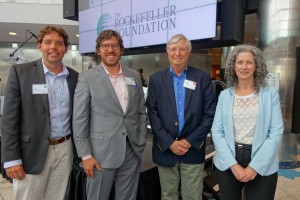
Each year the federal government spends billions of dollars rebuilding infrastructure following natural disasters. As we approach the 10-year anniversary of Hurricane Katrina, which cost the federal government $98 billion, and three-year anniversary of Superstorm Sandy, which cost $41 billion, federal agencies are beginning to rethink the way government responds to disaster.
Prompted in part by Superstorm Sandy, in 2013 Congress passed the $49 billion Disaster Relief Appropriations Act (Public Law 113-2). The Department of Housing and Urban Development (HUD) received $16 billion in Community Development Block Grants (CDBG) from the Act. Congress directed the funds to be used in the most “impacted and distressed areas” that experienced a qualifying natural disaster from 2011-2013. In an attempt to break free from the federal aid cycle of rebuilding back the same way, HUD decided to make $1 billion of the grant money available through a competitive grant process called the National Disaster Resilience Competition (NDRC).
While all government grants are competitive, HUD raised the stakes by teaming up with the Rockefeller Foundation to provide teams applying for a piece of the $1 billion with resources to bolster the strength of their application. The Rockefeller Foundation has a mission to help communities build more resilient and they saw the HUD competition as a great platform and partner in the federal government. Resilience—Rockefeller argues—helps communities better prepare for, respond to and transform from disruption.
The Foundation takes a much broader view of resilience than that of the traditional civil engineer who typically associates the term with stronger and longer lasting infrastructure—often developed through a rigorous full life cycle cost analysis. Through the NDRC, HUD and Rockefeller are seeking to make grants available for projects that showcase resilience not only via long lasting adaptable infrastructure, but also in jobs training programs, renewable energy projects, environmental stewardess and broader socially inclusive benefit to cost ratios. To ensure grant applicants put forth the best projects and programs possible for HUD funding, Rockefeller Foundation is providing capacity-building opportunities for the teams.
NDRC is split into two phases; the first phase required a team or “jurisdiction” to submit a concept of resiliency in their community (jurisdictions consisted of states, counties/parishes and cities). In July HUD announced 40 jurisdictions had been selected to move to Phase II. In this phase, teams will submit specific projects or programs for funding to HUD. To help teams prepare strong applications, Rockefeller Foundation organized two workshops in the form of “resiliency academies” and highly encouraged teams to take advantage of the nearly 100 subject matter experts Rockefeller was providing.
ASCE was invited to provide expertise at both resilience academies Rockefeller held in July. Amazingly all 40 jurisdictions spent the time and resources to send representatives to the Denver or Chicago academies to meet with economists, community leaders, environmental scientists, engineers and designers to discuss their project and program in detail and provide critical feedback to maximize and leverage the effectiveness of each idea.
Teams have until October to put together an application that wows a group of federal agency panelists who will be looking for projects or programs that are innovative, resilient and meet the needs of a diverse group of stakeholders in the community. The minimum grant available is $1 million; the maximum is $500 million.
